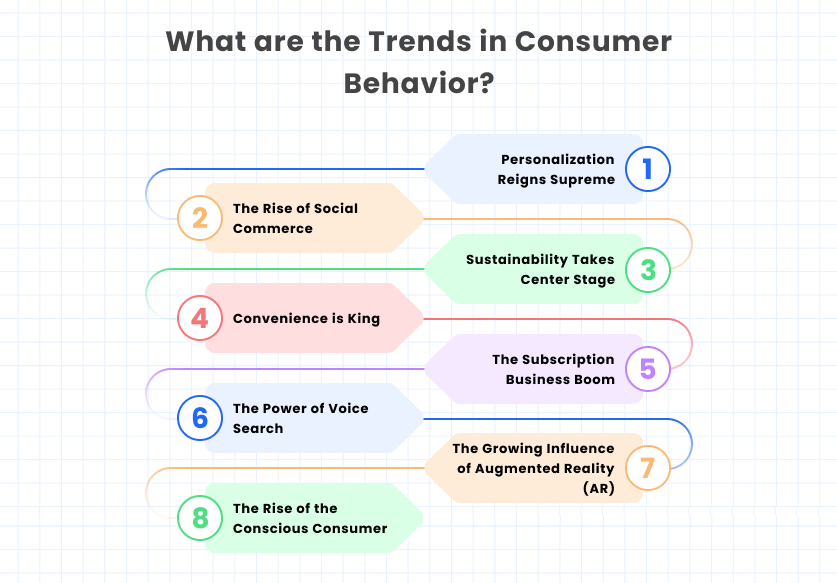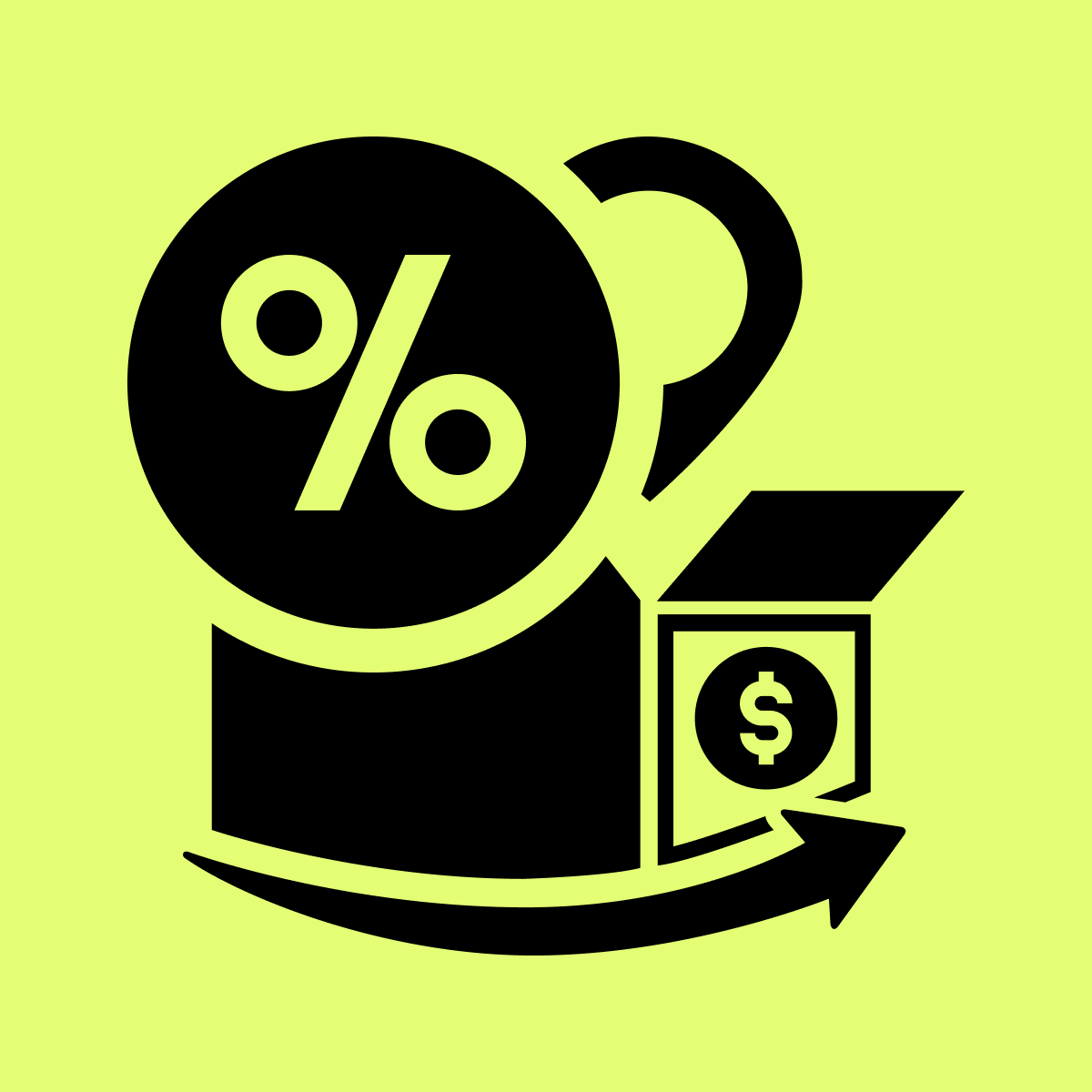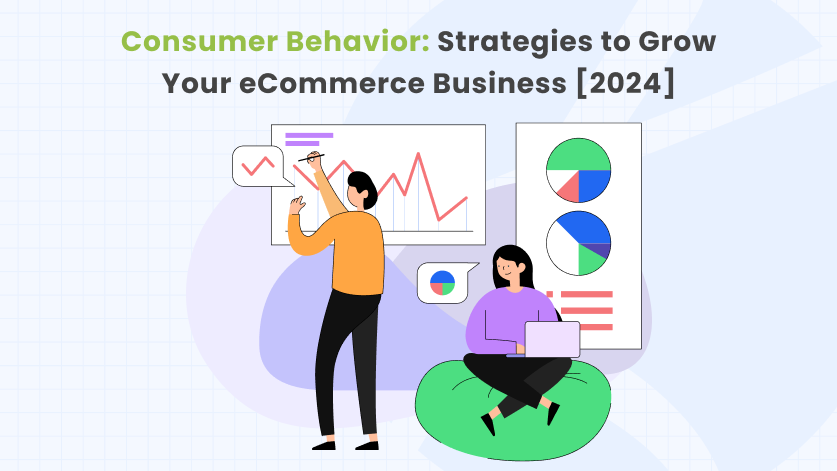Consumer behavior is the key to unlocking explosive growth in your eCommerce business. Consumer behavior is the lifeblood of every successful eCommerce business and is a powerful tool that can grow your online store for long-term success.
In this blog post, we delve into the depths of consumer behavior, exploring its multifaceted nature and uncovering the key strategies that can fuel the growth of your eCommerce enterprise in 2024.
Let’s start with our blog on customer behavior in eCommerce.
What is Consumer Behavior in eCommerce?
Consumer behavior in eCommerce is all about understanding how people shop online. It delves into the motives, thought processes, and actions that drive customers to browse, research, and ultimately purchase products through digital channels.
This knowledge is crucial for any online business, as it allows them to tailor their strategies and tactics to effectively attract, engage, and convert potential buyers.
Here’s a closer look at the different aspects of consumer behavior in eCommerce:
Factors Influencing Consumer Behavior When Shopping Online:
1. Convenience and Accessibility: The ability to shop anytime, anywhere from the comfort of one’s home is a major draw of eCommerce. Consumers can compare prices, read reviews, and make purchases on their own schedule.
2. Psychological: Needs, desires, emotions, and personality all play a role. Someone seeking warmth and comfort might be drawn to that sweater, while another might prioritize brand or ethical production.
3. Price Sensitivity and Deals: Online shoppers are often price-conscious and actively seek out deals and discounts. They compare prices across different platforms and are more likely to abandon a purchase if they find a better offer elsewhere.
4. Social Influence and Reviews: Recommendations and reviews from friends, family, and online communities heavily influence purchasing decisions. Consumers trust other people’s experiences and use them as a gauge for product quality and reliability.
5. Marketing: Product descriptions, visuals, reviews, and targeted ads all influence perception and decision-making. A compelling product description highlighting the sweater’s softness and warmth could convince the customer.
6. Technological: The ease of navigation, search functionality, and overall user experience of an online store heavily influence shopper behavior. A seamless interface can make the difference between a completed purchase and a reduced cart abandonment rate.
7. Personalization and Relevance: Consumers appreciate receiving personalized recommendations and offers based on their past browsing behavior and preferences. This creates a sense of value and connection with the brand.
8. Situational: Urgency, convenience, and budget constraints also come into play. A sudden drop in temperature or a limited-time offer might push the customer towards checkout.
What are the Foundations of Consumer Behavior?
Consumer behavior is the study of individuals’ buying habits, encompassing social trends, frequency patterns, and background factors influencing their purchase decisions.
For eCommerce businesses, it goes beyond demographics, delving into shopping frequency, product preferences, and the perception of marketing strategies.
Understanding customer behavior involves deciphering factors such as personality traits, psychological responses, and social trends.
According to the report by Salesforce, 66% of customers expect companies to understand their personal needs and expectations.
In eCommerce, customer behavior analysis extends beyond knowing who is shopping. It includes exploring how customers navigate the online shopping experience and informing businesses on effective communication and personalized offerings.
A Salesforce survey found that 73% of respondents expect businesses to accommodate their preferences, emphasizing the need for tailored approaches.
What are the Trends in Consumer Behavior?

Consumer behavior in eCommerce is constantly evolving, shaped by a confluence of technological advancements, social trends, and economic realities.
Here are some of the key trends to watch in 2024 and beyond:
1. Personalization Reigns Supreme:
Consumers crave experiences tailored to their individual preferences, needs, and buying habits. This means leveraging data to personalize product recommendations, offer targeted discounts, and deliver content that resonates with specific customer segments.
Imagine browsing for shoes and seeing recommendations based on your past purchases, preferred brands, and even foot size!
2. The Rise of Social Commerce:
Social media for eCommerce is no longer just for sharing product images. They’re becoming powerful shopping hubs, with features like shoppable posts, live video shopping, and influencer marketing driving significant sales.
Consumers are increasingly discovering and purchasing products directly through their social feeds, making it crucial for brands to have a strong social presence and engage with their audience in an authentic way.
3. Sustainability Takes Center Stage:
Eco-conscious consumers are prioritizing brands that align with their values. This means using sustainable packaging, sourcing ethically produced materials, and being transparent about environmental practices.
Consumers are willing to pay a premium for products that are good for the planet, making sustainability not just a feel-good trend but a smart business decision.
Learn more about sustainable eCommerce business with Shopify
4. Convenience is King:
Busy lives and tight schedules demand convenience. Consumers expect frictionless shopping experiences with fast delivery options, easy returns, and seamless customer journeys. Mobile wallets, one-click purchases, and voice shopping are gaining traction as people seek ways to shop quickly and efficiently.
5. The Subscription Business Boom:
From beauty products to pet food to curated book selections, subscription businesses are experiencing explosive growth.
Consumers appreciate the convenience and element of surprise that these boxes offer, and brands are capitalizing on the trend by creating personalized subscription experiences that cater to specific interests and needs.
Learn more about how to start a subscription business.
6. The Power of Voice Search:
The rise of voice assistants like Amazon Alexa and Google Assistant is transforming how we search for and purchase products. Consumers are increasingly using voice commands to shop online, making it crucial for brands to optimize their eCommerce store and product listings for voice search queries.
7. The Growing Influence of Augmented Reality (AR):
AR technology is giving consumers a virtual try-before-you-buy experience. Imagine trying on clothes virtually, seeing how furniture would look in your home, or even taking a test drive of a car from the comfort of your couch.
AR is poised to revolutionize the online shopping experience and make it more interactive and engaging.
8. The Rise of the Conscious Consumer:
Consumers are becoming more aware of the social and environmental impact of their purchases. They are looking for brands that are ethical, responsible, and give back to the community.
Supporting local businesses, choosing fair trade products, and buying from brands with a strong social mission are becoming increasingly important factors in purchasing decisions.
By staying ahead of these trends and adapting your business accordingly, you can position yourself for success in the ever-evolving eCommerce landscape. Remember, understanding your customers and their evolving behaviors is key to creating a thriving online business.
What are the Types of Consumer Behaviors in eCommerce?
Consumer behavior in eCommerce encompasses various types, reflecting the diverse ways in which individuals engage with online platforms and make purchasing decisions.
Understanding these types of consumer behaviors is essential for eCommerce businesses to tailor their strategies effectively.
Here are some key types of consumer behaviors in eCommerce:
1. Information-Seeking Behavior: Consumers often engage in extensive research before making a purchase. They seek information about product features, reviews, and pricing. eCommerce businesses need to provide detailed product descriptions, customer reviews, and comparison tools to cater to this behavior.
2. Impulse Buying Behavior: Some consumers make unplanned purchases based on immediate desires or attractive promotions. eCommerce platforms can capitalize on impulse buying behavior by showcasing limited-time offers, flash sales, and prominently displaying popular products.
3. Brand Loyalty: Loyal consumers consistently prefer products from a particular brand. Building and maintaining brand loyalty in eCommerce involves delivering a positive user experience, providing high-quality products, and cultivating a strong brand identity.
4. Comparison Shopping Behavior: Consumers frequently compare prices, features, and reviews across different platforms before making a purchase. eCommerce businesses must be competitive and transparent to appeal to consumers engaged in comparison shopping.
5. Social Influence Behavior: Consumers are often influenced by social media influencers and peer recommendations. eCommerce businesses can leverage social influence by incorporating user-generated content, collaborating with influencers, and actively engaging with customers on social platforms.
6. Repeat Purchase Behavior: Consumers who repeatedly buy from a particular eCommerce platform exhibit repeat purchase behavior. Providing incentives, loyalty programs, and personalized recommendations can encourage and reinforce this type of consumer behavior.
7. Deal-Seeking Behavior: Some consumers actively seek out discounts, deals, and promotional offers. eCommerce businesses can attract deal-seeking consumers through well-publicized sales events, discount codes, and loyalty rewards.
What are the Strategies for Consumer Behavior in eCommerce Business?
Implementing effective strategies for consumer behavior is crucial for the success of an eCommerce business. These strategies help businesses understand, engage, and influence consumers throughout their online shopping journey.
Here are explanations of key strategies for consumer behavior:
1. Personalization:
- Description: Personalization involves tailoring the online shopping experience to individual preferences and behaviors. This includes personalized product recommendations, targeted marketing messages, and customized content.
- Implementation: Use data analytics to understand customer preferences, employ recommendation engines, and utilize personalized email marketing campaigns. Providing a personalized experience fosters a sense of relevance and connection, enhancing the likelihood of conversion.
2. User Experience Optimization:
- Description: A seamless and user-friendly online experience is crucial for retaining customers. This involves optimizing website navigation, ensuring fast load times, and simplifying the checkout process.
- Implementation: Conduct regular usability testing, invest in responsive web design for mobile users, and continuously analyze user feedback. A positive user experience reduces friction and encourages repeat visits and purchases.
3. Social Proof and Reviews:
- Description: Consumers often rely on the experiences of others to inform their purchasing decisions. Social proof, such as customer reviews, ratings, and testimonials, can significantly influence consumer trust and confidence.
- Implementation: Encourage customers to leave reviews, prominently display positive feedback on product pages, and engage with customers on social media. Addressing negative reviews transparently also contributes to building trust.
4. Omnichannel Presence:
- Description: Consumers may interact with a brand across various channels, including websites, social media, mobile apps, and physical stores. An omnichannel strategy ensures a consistent and cohesive experience across all touchpoints.
- Implementation: Integrate online and offline channels, offer seamless transitions between platforms, and provide a unified customer account. A cohesive omnichannel approach enhances brand visibility and accessibility.
5. Influencer Marketing:
- Description: Leveraging influencers to promote products can be highly effective, especially on social media platforms. Influencers can help reach a broader audience and provide authentic recommendations.
- Implementation: Identify influencers aligned with your brand, collaborate on sponsored content and encourage user-generated content through influencer partnerships. Influencers can bring credibility and authenticity to your brand.
6. Limited-Time Offers and Discounts:
- Description: Creating a sense of urgency through time-limited promotions and discounts can stimulate impulse purchases and attract price-sensitive consumers.
- Implementation: Use flash sales, limited-time discounts, and exclusive offers. Clearly communicate the time-sensitive nature of the promotions to encourage immediate action.
7. Remarketing and Retargeting:
- Description: Many consumers abandon their shopping carts or browse products without making a purchase. Remarketing involves targeting these individuals with relevant ads to bring them back to the site.
- Implementation: Implement retargeting ads on social media and other websites, send abandoned cart emails with incentives, and use dynamic product ads. Reminding consumers of their initial interest can rekindle their intention to purchase.
8. Chatbots and AI-Assisted Support:
- Description: AI-powered chatbots can enhance customer support by providing instant responses to queries, guiding customers through the shopping process, and offering personalized recommendations.
- Implementation: Integrate chatbots into your website, mobile app, or messaging platforms. Train chatbots to handle common customer inquiries and seamlessly escalate more complex issues to human support.
9. Continuous Data Analysis:
- Description: Regularly analyzing consumer data provides valuable insights into changing preferences, behaviors, and market trends. Businesses can adapt their strategies based on real-time data.
- Implementation: Utilize analytics tools to track website performance, user behavior, and sales data. Conduct A/B testing for website elements and marketing campaigns. Data-driven decision-making ensures that strategies remain relevant and effective.
What are the 5 Roles in Consumer Behavior?
When it comes to consumer behavior, especially in online business, understanding the roles individuals play in a purchasing decision is crucial.
These roles help us map out the journey a product takes from spark of interest to purchase, and by understanding them, we can tailor our marketing and sales strategies to effectively reach and influence the right people at the right time.
Here are the five key roles in consumer behavior:
1. Initiator:
This is the person who first suggests the idea of buying a particular product or service.
They might be:
- The problem identifier: They notice a need or desire that a product could fulfill, like noticing the family car is getting unreliable and suggesting a new one.
- The trend follower: They see something trending or popular and spark the idea of getting it within the family, like suggesting a new gaming console based on online hype.
- The problem solver: They identify a specific problem that a product could address, like suggesting a subscription meal kit to save time on cooking.
2. Influencer:
This person’s opinions, recommendations, or advice significantly impact the buying decision.
They could be:
- The expert: Someone with knowledge or experience related to the product, like a friend recommending a specific brand of running shoes.
- The trusted source: A family member or close friend whose opinions hold weight, like a parent recommending a reliable car mechanic.
- The social media influencer: Online personalities or reviewers whose endorsements carry sway, especially for younger generations.
3. Decider:
This is the individual who has the final say on whether or not to purchase the product.
They might be:
- The head of household: Someone responsible for family finances and major purchases, like a parent deciding on a new family vacation.
- The primary user: The person who will be using the product most, like a child choosing their own sports equipment.
- The financial gatekeeper: Someone who controls the budget and has the final say on spending, like a spouse or partner.
4. Buyer:
This is the person who actually makes the purchase and pays for the product.
They might be:
- The same person as the decider: In some cases, the person who makes the final decision also handles the purchase.
- Someone else authorized by the decider: For example, a child might ask their parent to buy them a toy after getting their approval.
- Someone with access to the necessary payment method: If the decider doesn’t have their own credit card or other payment method, they might ask someone else to make the purchase for them.
5. User:
This is the person who consumes or uses the purchased product or service.
They might be:
- The same person as the buyer: This is often the case for personal purchases like clothing or food.
- Someone else within the household or group: For example, a family might buy a new board game, but everyone in the family will use it.
What are the 7 O’s of Consumer Behavior in eCommerce?
The “7 O’s” of consumer behavior in eCommerce refer to a framework that helps understand the factors influencing online purchasing decisions. While there are slight variations in the specific O’s depending on the source, the most common ones are:
1. Occupants: Who is the consumer? This includes their demographics (age, gender, income, etc.), psychographics (interests, values, personality), and lifestyle. Understanding their characteristics helps tailor marketing and product offerings to resonate with them.
2. Objects: What are they buying? This refers to the product or service itself, its features, benefits, and perceived value. Addressing the “what” helps eCommerce businesses highlight the product’s strengths and cater to specific needs.
3. Objectives: Why are they buying? This focuses on the motivations behind the purchase. Are they seeking functional benefits, emotional benefits, or social benefits? Understanding the “why” enables targeting messaging and aligning it with consumer motivations.
4. Organizations: Who influences the purchase decision? This includes family, friends, social media influencers, brands, and online communities. Recognizing their influence helps develop strategies to leverage positive word-of-mouth and address potential concerns.
5. Operations: How do they buy? This refers to the shopping process itself, including search behavior, website navigation, payment methods, and delivery options. Optimizing the “how” creates a smooth and convenient purchase experience.
6. Occasions: When do they buy? This considers the timing of purchases, such as seasonal trends, holidays, or special events. Identifying buying triggers allows for targeted marketing campaigns and promotions.
7. Outlets: Where do they buy? This encompasses the platform or channel used to purchase, such as specific websites, mobile apps, marketplaces, or social media. Understanding the “where” helps optimize the chosen channels and reach the target audience effectively.
By analyzing these 7 O’s, eCommerce businesses can gain valuable insights into their target customers’ behavior, preferences, and decision-making process.
Conclusion:
In conclusion, understanding consumer behavior is paramount for any eCommerce business to succeed in 2024 and beyond.
As we’ve explored the multifaceted facts of consumer behavior, it becomes evident that understanding the motivations, preferences, and evolving trends of online shoppers is the key to unlocking unprecedented growth.
Consumer behavior in eCommerce is a dynamic interplay of convenience, psychology, social influence, and technological advancements.
The foundations of consumer behavior extend beyond demographics, encompassing the intricate web of shopping frequency, product preferences, and the perception of marketing strategies.
Trends in 2024 shed light on the rising importance of personalization, the transformative role of social media in commerce, the emphasis on sustainability, the reign of convenience, the subscription business boom, the influence of voice search and augmented reality, and the emergence of the conscious consumer.
Delving into the various types of consumer behaviors, from information-seeking and impulse buying to brand loyalty and social influence, equips eCommerce businesses with the insights needed to tailor strategies effectively.
The implementation of key strategies, including personalization, user experience optimization, social proof, omnichannel presence, influencer marketing, limited-time offers, remarketing, and continuous data analysis, is crucial in engaging and influencing consumers throughout their online shopping journey.
Recognizing the distinct roles consumers play in the purchasing decision — from initiators and influencers to deciders, buyers, and users — allows businesses to craft targeted marketing and sales strategies that resonate at each stage of the journey.
Finally, the “7 O’s” framework is the essence of consumer behavior in eCommerce, providing a comprehensive guide to understanding occupants, objects, objectives, organizations, operations, occasions, and outlets.
I hope this article helps you! If you have any questions, please comment below!








